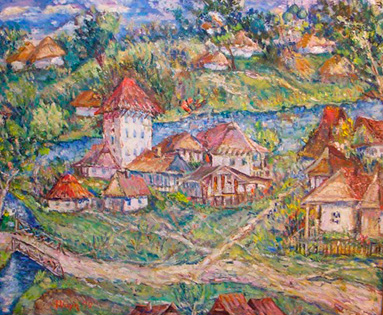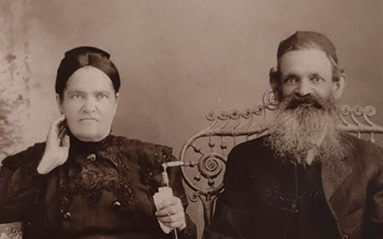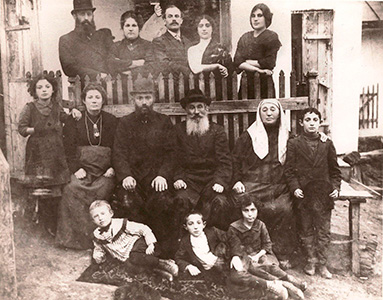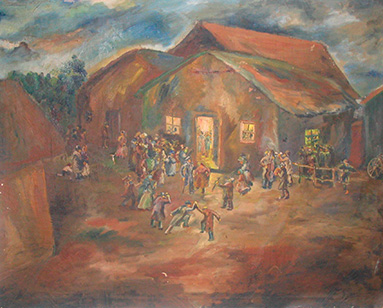
Ostropol, Ukraine
Stary Ostropil , Ostropolya, Ostropolia, אסטראפאער (Yiddish), Старий Острополъ (Ukr), Старый Острополъ (Rus)
By Myron J Echenberg and Ruth Echenberg Tannenbaum.

Early Map of Poland Empire
I. Early Jewish Life in the Ukraine.
Our family's beginnings derive from a single ancestor, Moses, of whom only the barest facts have been transmitted orally. We know only that he was born at the beginning of the nineteenth century in the Jewish shtetl town of Ostropol, in the province of Volynia, located in the heart of the Ukraine, Eastern Europe's bread basket. Who his parents were, and why our family history begins with Moses are questions we simply cannot answer. We do know that our founder Moses had two families, an older branch descended from his first wife, and a junior branch from his second marriage upon the death of his first spouse. However obscure the personal circumstances of Moses were, it is possible to place him in historical context. While Jews had been living in Volynia for at least five centuries at the time of Moses's birth, all the peoples of the region, Ukrainians, Poles, and Jews alike, were in the midst of a major political transformation. In 1793 the second partition of Poland had just occurred, bringing most of the Ukraine, and all of the province of Volynia under formal Russian rule for the first time. Further west in France, aRevolution which would change the map of Europe and its ideology forever, was in full swing.

Ostropol by Iask Vaynshelboym
Our founder may very well have been the first Echenberg even if he was assuredly not the first Jew of Ostropol. While Jewish life in the Ukraine can be traced back to antiquity, it is more likely that our ancestors first settled there as part of a large-scale eastern migration of Ashkenazi Jews from German speaking to Slavic lands beginning in the late twelfth century. One reason why our family history begins so relatively late may be that, save for great rabbinic scholars, Eastern European Jews did not place much emphasis on genealogy and individual family history as opposed to study of the Talmud and the collective history of the Jewish people. A second reason may be linked to nomenclature. While some Jews of the East had adopted formal patronymics or family names, most Jews, and indeed, most Gentiles in Eastern Europe used the older, biblical practice of using their father's name to identify themselves, for example, as Moshe Ben Avrum, or Rachel bas Avrum, which were rendered in Polish or Russian as Moshe Abramovitch and Rachel Abramovichova. It may be that one of the first consequences of the transfer in Ukrainian sovereignty from Poland to Russia that marked the period of our ancestor's birth was that Jews would now be required to adopt formal patronymics. While some may have enshrined their family names as Abramovitch, others chose place names, such as Nemirov, or occupational names such as Schechter (butcher), Schuster (shoemaker). Our own name seems to be the Yiddish, "Hech en barg", or "high on the hill", perhaps denoting the family residence on raised land. The topography of the Ukraine is such that "Mountain", or "Lamontagne" would not be appropriate anglicanization or francization of our name, but "Hill" would be closer to the original Yiddish. It should be noted that two sisters of Leon and Reva Echenberg, Munya and Buzya, who stayed on in Russia and became secular participants in the emancipation of Jewish women in early years of the Russian Revolution russified their names to Goryna, the feminine for Goryn, or Goren, which is Russian for hill.

Samson Echenberg & his wife
Kaila Freida Rosenbloom (b. 1835)
He was the son of the original Moses Echenberg of Ostropol who chose the Echenberg patronymic. He emigrated to Sherbrooke with his 4 sons and 1 daughter. The Echenberg family made its living as egg merchants. They were part of a very long standing economic activity, the exporting of agricultural products from Eastern to Central and Western Europe. They purchased eggs in volume from local Ukrainian peasants at the Ostropol market, and also had Jewish peddlers collect eggs from the countryside directly; they then exported this product west to the Austro-Hungarian Empire. It is probable that our ancestors were involved in this particular commerce for generations. In the late nineteenth century, several branches of the family were employed in various facets of the egg business, supervising purchase, sorting and packaging, and long-distance exporting of this commodity. " The latest statistics with regard to the importation of Russian farm produce into England fully bears out the review that English agriculture would do well to wake up and "look alive". It has long been know that Russia supplies England with nearly half as much wheat, oats and barley as are grown in the whole of England. But it could scarcely have been believed that Russia, amoung other items, supplies England with 200,000 eggs a year. What a disastrous testimony." From the "International Herald Tribune " Paris: May 15, 1895 Several Echenberg families have preserved a memory of this particular business, which was under the overall direction of Alter Echenberg and his wife Rachel. Rachel ran the business in Ostropol, pouring over her accounts from morning to night with consummate attention to every last detail, her glasses perched at the tip of her nose. Alter lived near the Austrian border at Volochisk for most of the year, supervising the exporting of eggs to the Austro-Hungarian Empire. On occasion he would himself cross the border into Austria, and, more rarely, travel to Vienna and other major cities of Central Europe. Leon and Reva recount how their grandfather Alter would return home twice a year for Yom Tov with special little gifts, such as oranges, dates, and even a perambulator with metal wheels, items entirely new to the industrially backward Ukraine. On the other hand, Alter, who was an extremely traditional and pious Jew in dress and deportment, was not a vehicle for modernization of Echenberg family life. Grandmother Rachel, or Baba Rachel as she is affectionately remembered, was clearly the driving force behind the family egg business, while Alter did the travelling, and, perhaps, the studying of Talmud and dedication to prayer that filled much of the observant Jew's daily life. Baba Rachel was reputed to be an extremely shrewd and tight-fisted lady whose habit it was to hoard children's new pencils and other small gifts against emergencies. Still, such excessive frugality was born of necessity, given the sometimes precarious existence of these fragile communities.

Alter Echenberg and his family in Ostropol, c 1895
Alter and Rachel Echenberg headed a family of status and authority in the shtetl. Their relative prosperity, Alter's piety, and Rachel's intelligence combined to make them and the Echenbergs generally, balabatim, leaders of Jewish life and especially of the obligation or mitzvot of charity. For example, a balabatische family was expected to prepare twice as much food as was needed for Sabbath, for distribution to the poor. We do not know for certain whether the pioneer of our family, Moses, son of Samson and Clara Echenberg, actually worked for a time in the egg business before he left for the New World at the age of twenty-three in 1886. He was of the junior branch of the Echenbergs, his father Samson having been a half-brother of Tevye, Alter's father, and therefore a "half-.first cousin" of Alter. Perhaps, given the growing economic pressures on Jews in late nineteenth century Ukraine, it may have been that Moses's prospects in the egg business were not great, and that it was precisely this economic motivation which prompted him to set out like millions of other immigrants in search of better opportunities in the New World. While we have no evidence for this construction, we can more confidently state that Moses shared with Alter Echenberg's senior branch the values of a balaboss. As we shall see, he and his younger brother Menassa were to become the leading Echenberg balabatim of Sherbrooke, our New World shtetl. By the later part of the nineteenth century, economic and social changes were reflected in the family activities. While the older generation remained as· agricultural exporters, Alter's son Moses, a bearded but much more secular man, earned his living as a minor government official, the magistrate, or staritsa, for Jewish residents of Ostropol, who needed passports to travel within the Tsar's lands and documents to indicate their military status with regard to universal conscription. A cousin, Charles or Shame Kitner, was a watchmaker in Ostropol. A family photo taken in Ostropol around 1910 depicts Shame's small shop in the background. Shame remained a watchmaker and retail jeweler in the New World, opening retail stores in the Eastern Townships of Quebec, first in Megantic, and later in Drummondville. His sons Myer and Murray continued and greatly expanded Kitner Jewellers, opening branches in several Quebec towns and cities, including Montreal. Though semi-retired, Myer in Montreal, and Murray in Florida, both continue to be active in the jewellery business. One of Shama's grandsons, Bart, has specialized in that most timeless of jewels, gold, representing at least the third generation in this trade. Alas, as far as we can tell, however, no Echenbergs are still in the egg business.

Figure 1 Murray Kitner and family standing
in front of his jewelery store in Ostropol
Whatever the small economic successes of Echenbergs in Ostropol, there was not enough opportunity to provide a livelihood for an expanding family. Even in normal times, out-migration would have been a logical expectation, and Jews of nineteenth century Russian Ukraine did not live in normal times. Why Echenbergs migrated across thousands of miles of land and water to the Eastern Townships of Quebec is not so obvious, however, even though, in this as in other aspects, our family's history follows very closely the patterns for Ukrainian Jews as a whole. To put our family emigration in context, a brief examination of the main lines of Jewish History in Eastern Europe is in order.

Jewish beginnings in the Ukraine
Ostropol in original 15th Century map.
A Jewish presence in what became Russia dates back to Antiquity. As early as the eleventh century when the Princes of Kiev were accepting Greek Orthodoxy, Jews were residents of that city. Kiev was in trading communication, and sometimes at war with the Crimea, an area of concentrated Jewish trade and culture from ancient times, settled by Jews who migrated there directly from the Middle East. In addition, the Khazar rulers of a state in the Crimea converted to Judaism. But the numbers of Jews in Eastern Europe grew significantly beginning with the First Crusade (1096) and especially after the Second (1147) and Third(1189-1192), when conditions in Germany became difficult for Jews.

Ostropol in relationship to 20th Century Poland.
Jewish immigrants poured into Poland, first in border provinces of Cracow, Posen, Kalisz, and Silesia. By numbers and superior training in Judaism, these immigrants imposed their German dialect on Polish Jewry, gradually producing the Yiddish language. Jews rose to positions of considerable importance under the protection of the Polish princes, as administrators, farmers, artisans, and generally as a middle stratum between nobles and peasants. Banking became an especially important activity as the medieval doctrine held that Jews were the property of the Crown, empowered to be moneyed men so as to supply the treasury with funds. Greatest gains were made under Casimir the Great, 1333-1370, during which time more German Jews flocked to his lands. Jews were permitted to rent or mortgage estates of the nobility, and to have unrestricted domicile in any of the cities or villages. It is possible that the Jewish shtetl in Ostropol dates back to Casimir's time in the mid fourteenth century. By the beginning of the fifteenth century, however, relations had deteriorated, highlighted by the old calumny of Jewish ritual murder of Christian children, this time brought forward in Cracow during Easter of 1407. It led to one of the first vicious pogroms, with the Jewish quarter attacked, many killed, children baptized, property looted, and dwellings set on fire. The Polish king Casimir IV, who ruled in the mid fifteenth century, wished to protect Jews and secure a Polish foothold on the Baltic seaboard against the Teutonic Knights. But a military defeat cost him this goal and forced him to make concessions to the Polish nobility that marked the beginnings of curtailment of royal powers in Poland relative to the nobility. Jews suffered as a result, without a strong monarchy to protect them. A weakened royal authority could not prevent local magistrates from restricting Jews from urban life and occupations. Guilds excluded Jewish artisans and ghettos became strictly enforced in such Polish cities as Posen. Warsaw permitted no permanent Jewish residents while limiting Jewish merchants to no more than a two or three day stay. These constraints pushed Jews further east and south into the smaller towns and rural villages of such Ukrainian provinces as Podolia, Volynia, and Kiev, where Jews took on the vulnerable position as middle men between Polish nobles and Ukrainian peasant serfs. Compared to harsher conditions and expulsion orders in Western and Central Europe, however, the East continued to be a region of relative security for Jews. Migration and population growth saw the numbers of Jews under Polish rule rise from 50,000 at the beginning of the sixteenth century to half a million by the mid-seventeenth. This period established the high water mark of Polish Jewry, intellectually and materially. Jews were not restricted to money-lending or petty trade; they were active producers and manufacturers in various industries. Some leased and administered Crown domains and estates of the gentry. Jewish capitalists worked salt-mines or dealt in timber and Jewish merchants exported the agrarian products of the country beyond the border. The poorer classes were traders, craftsmen, or tillers of the soil. Our family's egg business, therefore, reflected a typical middle stratum economic activity of Jews in the eastern lands. Modern Jewish historians are revising earlier impressions of Jewish History in the Diaspora. They are contesting what one scholar has called "lachrymose history", the view that Jews in the Diaspora have experienced nothing but persecution and suffering for over two thousand years. While not denying the irrefutable evidence of brutal discrimination and persecution at various dark moments, the new school points out that .Jews have also experienced long periods of stability, allowing for rich spiritual and cultural expression, and an economic condition that was superior to that of most of the other peoples among whom they lived.

An Evening in Ostropol, Matthew Mosenkis.
The Polish Ukraine from the reign of Casimir the Great in the mid fourteenth century to the "time of troubles" ushered in by the Cossack rebellion under Bogdan Chmielnicki some two hundred years later, in 1648, was one such region of relative Jewish well being. As food exporters living in one of Europe's most fertile regions, our ancestors lived comfortably. Jewish spiritual life flourished under Polish rule, with many centres of learning stretching from Cracow in Western Poland to Zhitomir near Kiev. Ostropol was a typical shtetl in the centre of Volynia, itself the geographic centre of the Polish Ukraine. Two of its most famous sons, Samson or Shimson ben Pesah Ostropoler, and Hershele Ostropoler, have given the town renown in .Jewish philosophy and popular culture respectively. No details of Shimshon's life are known save through his own writings. He was regarded throughout Poland as the greatest Kabbalist in the country, a powerful mystic who concerned himself with numerological mysticism and demonology. He served as preacher in Polonnye, not far from Ostropol, where he died a martyr's death in 1648, a victim of the Chmielnicki massacres. Ostropol is also associated in Jewish folklore with the late eighteenth century humorist known as Hershele Ostropoler. He was born in Balta in the neighboring province of Podolia, and lived most of his life in Medzibozh, where he died. But his name derived from Ostropol because he served there for a time as a shohet. Many stories associated with Hershel have been recorded by such giants of .Jewish literature as Shalom Alecheim and Isaac Bashevis Singer. Some may not be authentic but there is no doubt Hershel actually existed and admirably reflected the sort of wry humour often associated with persecuted minorities. The following story, recounted by Leon Echenberg, who heard the story from his father Moses, nicely demonstrates the ability of shtetl Jews to fight discrimination with humour. One day Hershel was visiting a village some distance from Ostropol when the local Polish lord, accompanied by his entourage, rode into the main square. All the locals took off their hats and bowed in subservience to this powerful figure, all, that is, except Hershel. When the lord noticed that Hershel was not following the village practice he ordered his coachman to stop in front of this cheeky Jew. " Where are you from?'', the lord angrily snapped, whereupon Hershel replied, "from Ostropol". "What about the hat?" asked the lord. And Hershel answered, "The hat too is from Ostropol," The Chmielnicki uprising of the mid seventeenth century marked a period of considerable unrest in Europe generally (English civil wars, inflation and decline in Spain, religious wars in Germany). In 1648 the Cossack leader Bogdan Chmielnicki, led a revolt against the Polish nobility, After defeating the Polish army, his followers joined with local Polish and Ukrainian peasants in attacking the Jews. Spasmodic violence continued for eight years, with an estimated 100,000 Jews killed; many others were tortured or ill-treated while others fled to Holland, Germany, Bohemia and the Balkans. No anti-Jewish massacres were recorded for Ostropol but the town could not escape the anti-Semitic hatred boiling throughout the region, Shimson Ostropoler himself was martyred at the head of his community in Polonnye, which was less than one day's travel from Ostropol. Persecutions and pogroms continued during the period of Muscovite occupation of Volynia, Podolia, and Kiev until the Polish army was able to put down the rebellion and drive off the Muscovite invader in 1667. One consequence of the holocaust was the rise of messianism, specifically the movement of the false messiah Sabbatai Zevi. Although he was a Sephardic Jew born in Smyrna (Izmir) in the Ottoman Empire, he acquired a large following among the spiritually and economically devastated Ashkenazi communities of Eastern Europe. An even more important new movement was that of Hasidism or Pietism which arose in the province of Podolia, immediately west of Volynia, where Jewish misery was at its worst. Among its other features, this new mystical movement, while not itself sectarian, aroused doctrinal splits in an already hard pressed Jewish community. Under these circumstances the centres of Jewish culture and learning moved north to Poland and Lithuania, leaving the Jewish Ukraine to become an impoverished commercial and intellectual backwater.

Jewish beginnings in the Ukraine
Ostropol in original 15th Century map.
A Jewish presence in what became Russia dates back to Antiquity. As early as the eleventh century when the Princes of Kiev were accepting Greek Orthodoxy, Jews were residents of that city. Kiev was in trading communication, and sometimes at war with the Crimea, an area of concentrated Jewish trade and culture from ancient times, settled by Jews who migrated there directly from the Middle East. In addition, the Khazar rulers of a state in the Crimea converted to Judaism. But the numbers of Jews in Eastern Europe grew significantly beginning with the First Crusade (1096) and especially after the Second (1147) and Third(1189-1192), when conditions in Germany became difficult for Jews.